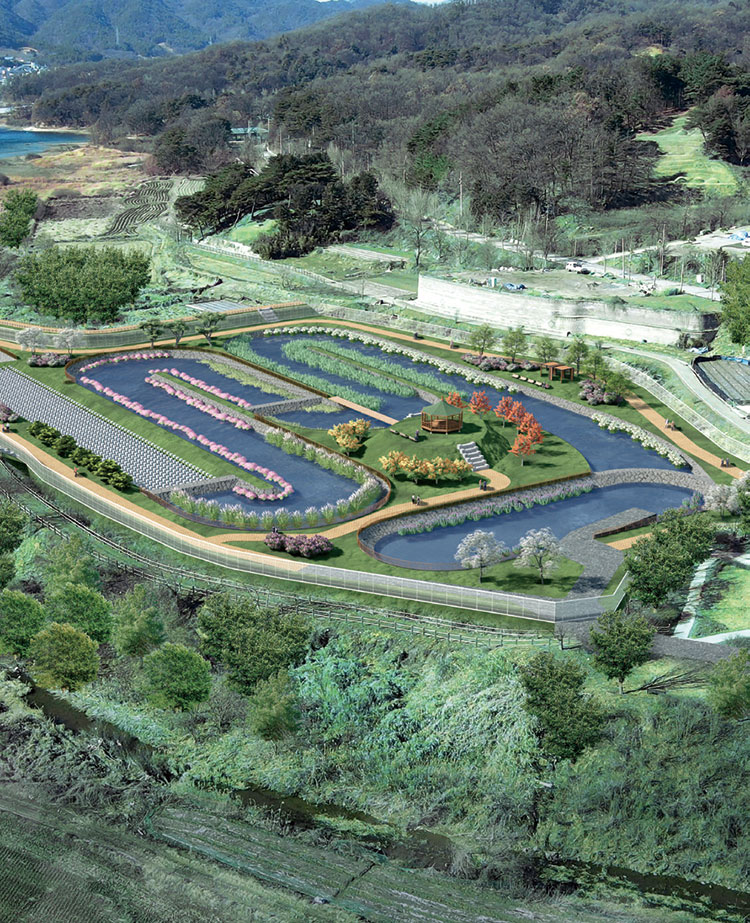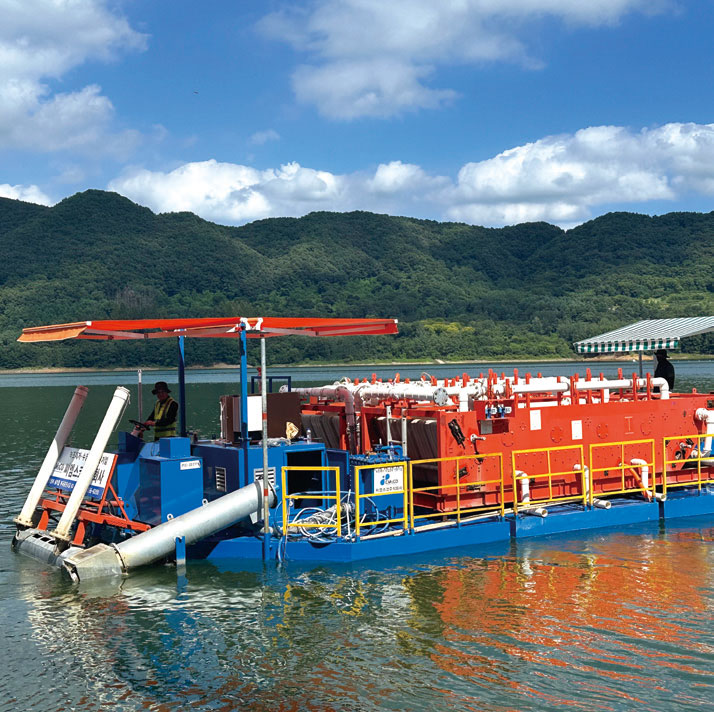Focus on
Climate Anomalies Pose an Increasing Threat to Water Safety
All-Out War against Algal Blooms!
Summer is a time for battle with algal bloom!
This summer has been characterized by extreme heat and heavy rainfall,
resulting in the issuance of algal bloom warnings.
It is becoming increasingly necessary to tighten up the response to algal blooms
as the weather is expected to get hotter and hotter each year.
Amid such a situation, K-water is making an all-out effort to cope with algal blooms.
📝Text by. Editorial Team / 💾Source. Water Environment Management Department of K-water

A surface aerator and an algae-collection ship operating in the Andong Dam basin.
Algal Bloom, the Uninvited Guest of the Summer Season
What is the color of water? Many people will probably say it is clear blue. The water in rivers and lakes across the country is turning dark green after summer months plagued by heavy rainfall and extreme heat. An algal bloom is a rapid growth of blue-green algae or cyanobacteria, in other words photosynthetic microscopic organisms, in rivers or lakes, turning the water dark green. Algae grow most rapidly when the water temperature is 20-30℃, which is why algal blooms occur most frequently in summer.
The major reason for the presence of algal blooms is all the plants, trees and other sorts of waste that are washed into rivers and lakes during the flood season, along with livestock manure that flows in from cattle farms in upstream regions. All this organic matter carried into the water by floods increases the amount of nutrients, including nitrogen and phosphorus, in rivers and lakes, causing the temperature to rise and triggering eutrophication. As a result, cyanobacteria grow in much higher concentrations than natural levels.
Why do algal blooms matter? Algae generate oxygen and organic matter through photosynthesis, providing a source of primary food in the underwater ecosystem. But overgrowth of algae consumes large amounts of oxygen, and the resulting lack of oxygen in the water causes fish to die, disturbing the ecosystem. In addition, cyanobacteria generate foul odors as they grow and generate toxins that can be harmful to human health. For this reason, direct contact with algal blooms should be avoided. Four types of cyanobacteria, i.e. microcystis, anabaena, Oscillatoria, and aphanizomenon, have been classified as harmful microscopic organisms by the Ministry of Environment in order to facilitate stricter monitoring and management of them. Even if an algal bloom occurs in a water source, all the toxic materials and odors are filtered out as the water goes through the highly-sophisticated water purification process, making our tap water safe to drink.
-

An aerial view of the eco-filtering facility on Peumgokcheon Stream.
-

K-water staff inspecting the suspended solids treatment facility at Daecheongho Lake.
K-water Is Acting Quickly to Keep Our Water Clean
K-water is keeping water clean and safe from algal blooms by taking preventive and post-algal bloom measures. To prevent algal blooms, K-water monitors major sources of pollution and minimizes the inflow of nutrients into water which feed algae. The Ministry of Environment and K-water have identified key target areas in basins that are frequently affected by algal blooms or discharge large amounts of pollutants. They inspect these areas for pollutants, including suspended solids, abandoned livestock manure, fertilizers, and daily waste before the summer months begin, and take measures accordingly Moreover, non-contact pollution source reduction facilities will be introduced to fundamentally block pollutants from flowing into water sources as part of K-water’s water environment management project.
As lead projects, K-water started building non-contact pollution reduction facilities, including rainwater detention and filtering facilities and eco-filtering facilities, at Daecheong Dam and Juam Dam in 2022. Once these facilities are completed, the inflow of pollutants in the upstream regions of these dams is expected to decrease by more than 70%.
The key to responding to post-algal blooms is to collect the algae as quickly as possible.
Screens are installed around water intake towers to block algae from flowing into the water according to the level of warning issued by the algal bloom warning system, and water cycling equipment and a surface aerator to prevent the concentration of algae. Chemicals can also be used to eliminate algae if necessary. This year, twice as much algae-collection equipment as last year is being operated to ensure timely removal, and a weekly algal bloom forecast is provided to help make timely decisions and respond to algal blooms more effectively.
K-water plans to develop an integrated digital platform for the scientific and systematic management of algal blooms. Specifically, it will use artificial satellite data and drones to analyze distribution patterns in algal blooms, employ eco robots to monitor water quality as part of a multi-dimensional algal bloom monitoring system, analyze data collected by AI, and share the outcomes of water quality and algal bloom forecasts with related organizations in order to help them make timely and accurate decisions.
Thinking outside the Box: A New Approach to Dealing with Algal Blooms
Taking it one step further, K-water is trying a new approach to removing algae by using algae. Instead of harvesting algae, K-water has created a large “algae-combating field” in the upstream area of a dam. A large screen is set up in the upstream region to create the conditions necessary to induce the overgrowth of algae, and once they are overgrown the algae consume nutrients in the upstream area. This means fewer nutrients will flow into the water in the downstream area, thereby reducing algal blooms in the reservoir of the dam.
This summer, sudden local downpours and the scorching hot weather continued even after the flood season was over, creating the ideal conditions for algal blooms.
The government and other relevant organizations were put on heightened alert early on to respond to possible algal blooms, and they began concentrating all their efforts on ensuring a safe supply of clean water through strict pollutant management and the technical advancement of water purification processes. However, algal blooms are exacerbating each year around the world as the frequency and severity of extreme weather events continue to increase. As water temperatures and the quantity of solar radiation are beyond human control, the best way to stop algal blooms is to reduce the amount of pollutants flowing into our water resources. In order to keep water clean and safe, the public sector needs to come up with effective measures based on scientific analysis, and dispel baseless fears over algal blooms among the public through education. Above of all, we should all try to reduce the amount of waste we generate in our everyday life.
-

An algae collection ship operating at the Chilseo Intake Station of Haman Reservoir in Changnyeong.
-

An Eco Robot, an automated algae harvester.
-

K-water staff discussing ways to respond to the spread of algal blooms at an emergency meeting.
-

Real-time algae monitoring to ensure a timely response to algal blooms.
Quick Information on Algal Blooms

Q1. Are algal blooms a serious problem in other countries, too?
Algal blooms are a global phenomenon. The amount of pollutants discharged into rivers is increasing due to urbanization, industrialization, the expansion of the cattle farming industry and advanced farming practices. Moreover, temperatures are rising amid accelerating climate change, which is conducive to the proliferation of algal blooms. Korea is responding more actively than other countries to algal blooms by implementing proactive measures to prevent algal blooms, and is collecting algae directly from the affected bodies of water.
Q2. What are some of the things we can do in our daily life to help reduce algal blooms?
Algal blooms can be stopped when we prevent nutrients that cyanobacteria particularly like, such as nitrogen and phosphorus, from flowing into rivers and streams. To help stop algal blooms, you should reduce your domestic waste, including food waste, and should not wash your car or clothes in rivers or do any activities that can pollute rivers. Using fewer detergents when you do the laundry or wash dishes, or using proper amounts of certified eco-friendly detergents, can also help to reduce algal blooms.
